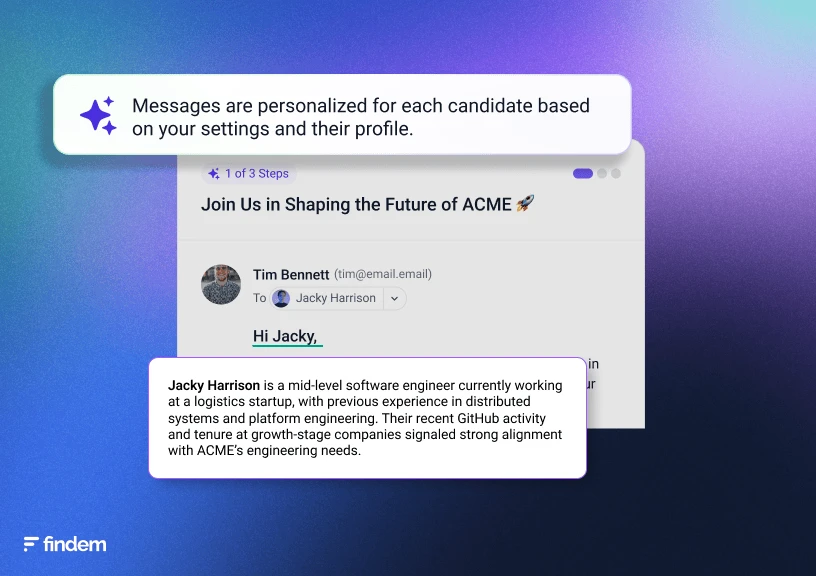.svg)
Inside the CHRO role: Trends, leadership attributes, and career paths
.svg)

.svg)
Using 3D data from Findem's Talent Data Cloud, we're surfacing insights that help talent teams uncover key industry trends, market shifts, and strategic opportunities.
The Chief Human Resources Officer (CHRO) role has been reinvented in the past four years, requiring leaders to navigate challenges that just a few years ago would have been unimaginable.
Top challenges for CHROs remain balancing a hybrid work model post-pandemic, integrating AI into their employees' day-to-day responsibilities, and addressing the nuanced intersection of workplace belonging and political/legal compliance. Discussions around skill-based hiring and Lean-In feminism have evolved, shaped by both greater complexity and heightened political polarization.
CHROs have been thrust into strategic leadership roles, often collaborating with CEOs and other leaders to ensure talent initiatives like digital innovation and employee engagement align with the company’s overall business objectives. Despite their strategic influence, CHROs continue to face barriers to c-suite recognition, with less than 5% of Fortune 500 CEOs coming from HR backgrounds.
In this blog, we’ll explore even more key insights into the CHRO role, from trends in gender representation to career paths and hiring patterns.
Finding #1: 49% of CHROs hired in 2024 were internal promotions
In 2024, nearly half of CHROs hired within Fortune 500 companies were internal promotions. Among external hires, 62% came from outside their industry, highlighting a growing openness to cross-industry expertise. Examples include:
External hires:
- DaVita appointed Jessica Hergenreter, formerly of Vail Resorts. Hergenreter spent 13 years at Vail Resorts before joining DaVita.
- Mondelēz International hired Stephanie Lilak, previously with Bumble. Lilak spent 2 years at Bumble before joining Mondelēz International
- SAIC welcomed Han-Ron Siah, who previously served at McDonald’s. Siah spent 2 years at McDonalds before joining SAIC.
Internal hires within the same industry:
- Gap Inc. promoted Amy Thompson, a long-time leader from Mattel. Thompson spent 6 years at Mattel before joining Gap
- USAA appointed Tami Cabaniss from PayPal. Cabaniss spent 9 years at PayPal before joining USAA
- Huntington Bank promoted Sarah Pohmer, formerly of JPMorgan Chase. Pohmer spent 24 years at JPMorgan Chase before joining Huntington.

Finding #2: Women are overrepresented as CHROs, but this has never been a feeder position for CEOs
Despite the fact that women make up 72% of CHROs at Fortune 500 companies, they’re still vastly underrepresented at the CEO level. According to Forbes, just 9% of all CEOs at such companies are women. The CHRO role has not traditionally been seen as a pathway to CEO positions, even though CHROs bring a level of strategic capability that would benefit any company’s highest-ranking position.
Finding #3: Representation for women is lowest at the Director level
While the CHRO position is a strong foothold for women in the C-suite, their representation often declines at the Director level before rebounding at the VP and CHRO stages.

According to Forbes, women are less likely to advance into leadership roles across key corporate functions like finance, marketing, and operations — areas that are traditionally seen as feeder paths to the C-suite. These systemic barriers suggest that organizations may need to adopt more targeted strategies to support women's advancement through mid-level and senior leadership positions.
Finding #4: CHROs tend to stay in the talent space
Many CHROs continue their careers within the talent ecosystem. When CHROs transition to new roles, they often take leadership positions in boutique human capital consulting firms or remain within C-suite roles such as Chief People Officer (CPO).
Common career paths include:
- Chief People Officer (CPO)
- Chief Human Resources Officer (CHRO)
- Principal at HR consulting firms
Finding #5: CHROs bring impressive credentials and leadership qualities to the role
CHROs share several key attributes that reflect their expertise and leadership capabilities, including:
- Long-tenured employee experience
- Fortune 500 executive background
- MBA education
- Global experience
- Leadership in Diversity, Equity, and Inclusion (DEI)
- A mission-driven mindset
This blend of qualifications underscores the strategic value CHROs bring to large organizations, particularly in guiding cultural transformation and global workforce strategies.
Uncover insights for any role with Findem
At Findem, we’re always on the lookout for new and developing roles in the business landscape. Findem’s Talent Data Cloud analyzes data from over 100,000 different sources to create 1.4 trillion unique and factual data points about the global workforce.
Chief HR Officer is a critical role in any company's digital and organizational transformation. Findem’s 3D data provides insight into who is getting these positions and what to look for in hiring.
Whether you are angling for the position of CHRO at your company or the executive recruiting team tasked with making the hire, we think you’ll find this breakdown useful.










